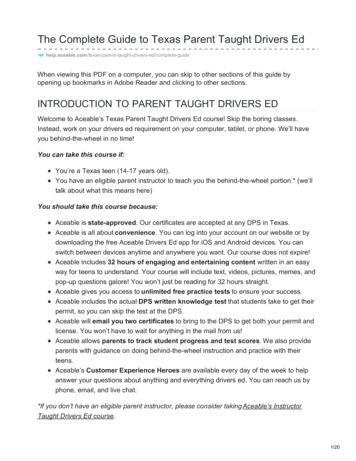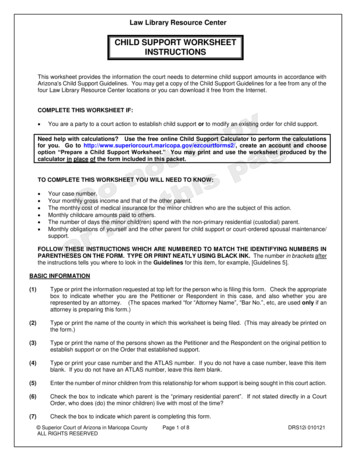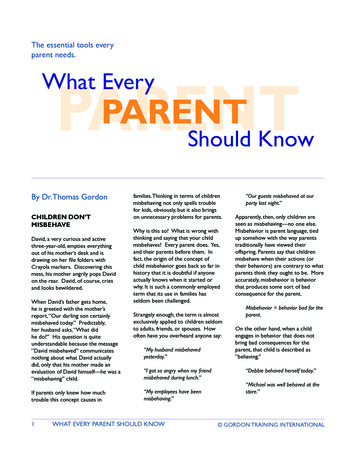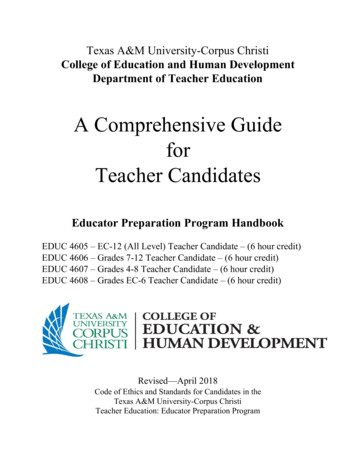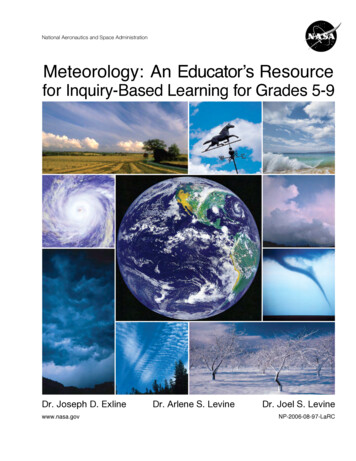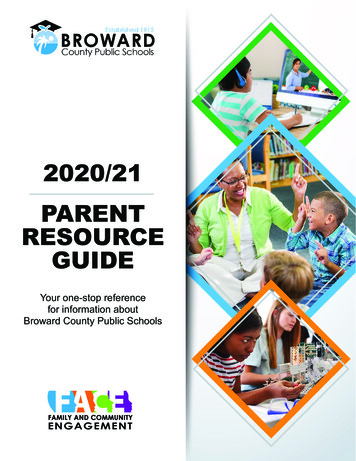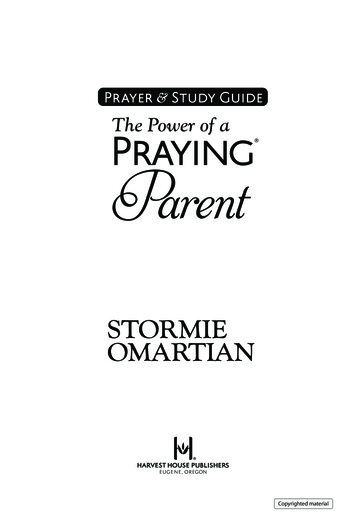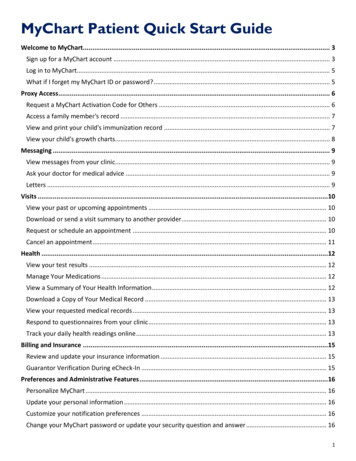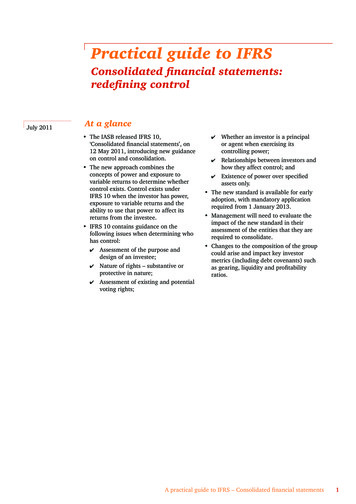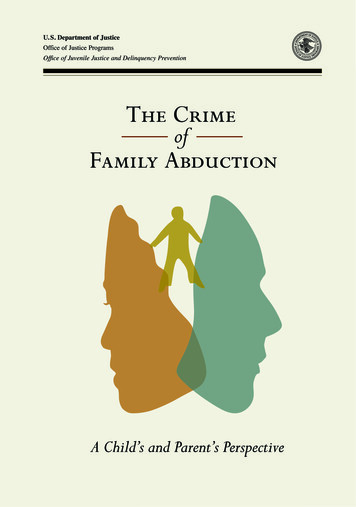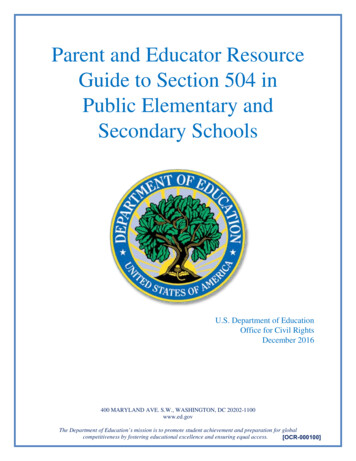
Transcription
Parent and Educator ResourceGuide to Section 504 inPublic Elementary andSecondary SchoolsU.S. Department of EducationOffice for Civil RightsDecember 2016400 MARYLAND AVE. S.W., WASHINGTON, DC 20202-1100www.ed.govThe Department of Education’s mission is to promote student achievement and preparation for globalcompetitiveness by fostering educational excellence and ensuring equal access.400 MARYLAND AVE. S.W., WASHINGTON, DC 20202-1100www.ed.govThe Department of Education’s mission is to promote student achievement and preparation for globalcompetitiveness by fostering educational excellence and ensuring equal access.[OCR-000100]
U.S. Department of EducationOffice for Civil RightsCatherine E. LhamonAssistant SecretaryDecember 2016This resource guide is in the public domain. Authorization to reproduce it in whole or in part isgranted. The resource guide’s citation should be:U.S. Department of Education, Office for Civil Rights, Parent and Educator ResourceGuide to Section 504 in Public Elementary and Secondary Schools (December 2016).This resource guide is also available on the Office for Civil Rights’ website html. Any updates to this resource guide will beavailable at this website.If you need technical assistance, please contact the OCR regional office serving your State orTerritory by: visiting m, or calling OCR’s Customer Service Team at 1 800-421-3481; TDD 1-800-877-8339; or emailing OCR at ocr@ed.gov.Availability of Alternate Formats: Requests for documents in alternate formats such as Brailleor large print should be submitted to the Alternate Format Center by calling 202-260-0852 or bycontacting the U.S. Department of Education’s Section 508 Coordinator via email atom eeos@ed.gov.
Parent and Educator Resource Guide to Section 504in Public Elementary and Secondary SchoolsNotice of Language AssistanceNotice of Language Assistance: If you have difficulty understanding English, you may, free of charge, request languageassistance services for this Department information by calling 1-800-USA-LEARN (1-800-872-5327) (TTY: 1-800-8778339), or email us at: Ed.Language.Assistance@ed.gov.Aviso a personas con dominio limitado del idioma inglés: Si usted tiene alguna dificultad en entender el idiomainglés, puede, sin costo alguno, solicitar asistencia lingüística con respecto a esta información llamando al 1-800-USALEARN (1-800-872-5327) (TTY: 1-800-877-8339), o envíe un mensaje de correo electrónico 。給英語能力有限人士的通知: 如果您不懂英語, �譯服務的詳細資訊,請致電 1-800-USA-LEARN (1-800-872-5327) :Ed.Language.Assistance@ed.gov。Thông báo dành cho những người có khả năng Anh ngữ hạn chế: Nếu quý vị gặp khó khăn trong việc hiểu Anh ngữthì quý vị có thể yêu cầu các dịch vụ hỗ trợ ngôn ngữ cho các tin tức của Bộ dành cho công chúng. Các dịch vụ hỗ trợngôn ngữ này đều miễn phí. Nếu quý vị muốn biết thêm chi tiết về các dịch vụ phiên dịch hay thông dịch, xin vui lònggọi số 1-800-USA-LEARN (1-800-872-5327) (TTY: 1-800-877-8339), hoặc email: Ed.Language.Assistance@ed.gov.영어 미숙자를 위한 공고: 영어를 이해하는 데 어려움이 있으신 경우, 교육부 정보 센터에 일반인 대상 언어 지원서비스를 요청하실 수 있습니다. 이러한 언어 지원 서비스는 무료로 제공됩니다. 통역이나 번역 서비스에 대해자세한 정보가 필요하신 경우, 전화번호 1-800-USA-LEARN (1-800-872-5327) 또는 청각 장애인용 전화번호 1800-877-8339 또는 이메일주소 Ed.Language.Assistance@ed.gov 으로 연락하시기 바랍니다.Paunawa sa mga Taong Limitado ang Kaalaman sa English: Kung nahihirapan kayong makaintindi ng English,maaari kayong humingi ng tulong ukol dito sa inpormasyon ng Kagawaran mula sa nagbibigay ng serbisyo na pagtulongkaugnay ng wika. Ang serbisyo na pagtulong kaugnay ng wika ay libre. Kung kailangan ninyo ng dagdag naimpormasyon tungkol sa mga serbisyo kaugnay ng pagpapaliwanag o pagsasalin, mangyari lamang tumawag sa 1-800USA-LEARN (1-800-872-5327) (TTY: 1-800-877-8339), o mag-email sa: е для лиц с ограниченным знанием английского языка: Если вы испытываете трудности впонимании английского языка, вы можете попросить, чтобы вам предоставили перевод информации, которуюМинистерство Образования доводит до всеобщего сведения. Этот перевод предоставляется бесплатно. Если выхотите получить более подробную информацию об услугах устного и письменного перевода, звоните потелефону 1-800-USA-LEARN (1-800-872-5327) (служба для слабослышащих: 1-800-877-8339), или отправьтесообщение по адресу: Ed.Language.Assistance@ed.gov.
UNITED STATES DEPARTMENT OF EDUCATIONOFFICE FOR CIVIL RIGHTSTHE ASSISTANT SECRETARYDear Superintendents and Other School Administrators:Thank you for the essential work you do to ensure that students with disabilities in the United Stateshave an equal educational opportunity. As school leaders, you are invaluable resources for people inyour district regarding the rights of students with disabilities under Section 504 of the RehabilitationAct of 1973 (Section 504). The U.S. Department of Education’s Office for Civil Rights (OCR)supports your efforts to help your schools comply with Section 504, including the Department’simplementing regulations, and looks forward to working with you to provide students with aneducational environment free from disability-based discrimination.The attached resource guide reminds all educational institutions receiving Federal financialassistance from the Department that they must vigilantly work to ensure compliance with Section504 and other Federal laws that protect students with disabilities. We intend this resource guide toalso help parents of students with disabilities understand the obligations imposed under Section 504.In particular, the resource guide summarizes key requirements of Section 504, and aims to increaseunderstanding of these requirements for both parents and members of the school community alike. Ifyou need technical assistance, please contact the OCR regional office serving your State or Territoryby visiting wdcrobcolp01.ed.gov/CFAPPS/OCR/contactus.cfm or call OCR’s Customer ServiceTeam at 1-800-421-3481; TDD 1-800-877-8339.Thank you for your commitment to assisting your schools in complying with Section 504 and toensuring that all your schools’ students have safe and healthy environments in which to learn andthrive. We in OCR look forward to continuing to work with you to help prevent and addressdisability discrimination in our nation’s schools.Sincerely,/s/Catherine E. LhamonAssistant Secretary for Civil Rights400 MARYLAND AVE. S.W., WASHINGTON, DC 20202-1100www.ed.govThe Department of Education’s mission is to promote student achievement and preparation for global competitivenessby fostering educational excellence and ensuring equal access.400 MARYLAND AVE. S.W., WASHINGTON, DC 20202-1100www.ed.govThe Department of Education’s mission is to promote student achievement and preparation for global competitivenessby fostering educational excellence and ensuring equal access.
TABLE OF CONTENTSIntroduction . 1The Meaning of Disability Under Section 504 . 3Physical or mental impairments . 3Major life activities. . 4Mitigating measures. . 6Substantial limitation . 6Episodic impairments . 7Record of a disability . 7Regarded as having a disability. . 8Qualified individual with a disability . 9An Overview of a Free Appropriate Public Education . 10Student Evaluations and Placement Under Section 504 . 12Scenario 1 – Suspected Disability & Evaluation . 14Scenario 2 – Suspected Disability & Involvement of Knowledgeable People. 15Scenario 3 – Disabilities in Remission . 15Scenario 4 – Appropriate Testing . 17Scenario 5 – Timeframes for Evaluation . 17Scenario 6 – Disagreement Over Need to Evaluate . 21Scenario 7 – Reevaluations and FAPE . 23Additional Considerations for Placement and Services Under Section 504 . 24Athletics and Extracurricular Activities. 27Physical Accessibility . 28Scenario 8 – Accessibility . 29Additional Protections from Discrimination. 30Scenario 9 – Unjustified Different Treatment . 31Bullying and Harassment . 32Disputes and Disagreements Regarding FAPE and non-FAPE Matters . 35Procedural Safeguards . 35Scenario 10 – Procedural Safeguards . 36Grievance Procedures . 37Retaliation . 38Title II and the IDEA . 40Conclusion . 44Other OCR Resources . 46
Page 1Parent and Educator Resource Guide to Section 504IntroductionIntroductionEvery year, public school teachers, leaders, parents, students, and other interested parties contactthe U.S. Department of Education’s Office for Civil Rights (OCR) asking questions about theeducational and civil rights of students with disabilities who are enrolled in public elementaryand secondary schools.In this resource guide, the term parent includes guardians and others withthe authority to act on behalf of and in the interest of a student.During these exchanges, OCR often hears (1) uncertainty about the Federal civil rightsobligations of public schools and individual school employees in a wide range of situationsinvolving students with disabilities; (2) a lack of awareness of required processes and proceduresfor securing services and access to programs and opportunities for students who have or mayhave disabilities; or (3) confusion about student rights under the applicable Federal disabilitylaws. As a result, some school officials may violate the Federal civil rights laws that are designedto protect students with disabilities. Similarly, some parents do not know what services andprotections their children with disabilities may be entitled to receive or how to appropriatelyinitiate or follow the process and procedures for securing disability services for their childrenfrom the school.To facilitate efforts to eliminate discrimination against students with disabilities, OCR offers thisresource guide to provide answers to questions that OCR has received and increaseunderstanding among parents and members of the school community of the Federal civil rightslaws that protect students with disabilities in public schools, and in particular, Section 504 of theRehabilitation Act of 1973 (Section 504). 1Imbedded in the discussion of key provisions of Federal law, the resource guide repeatedly asksparents, teachers, and others to think about how they might respond in different scenarios. Forexample:What should parents do when their child appears to need extra help inschool, and they believe their child may have a disability?What kinds of assistance are available?Who should parents speak with about their concerns and questions?What are teachers, administrators, and other school employees required todo for a student who has or may have a disability?129 U.S.C. § 794; 34 C.F.R. pt. 104.
Page 2Parent and Educator Resource Guide to Section 504IntroductionSection 504 is a Federal law that prohibits disability discrimination by recipients of Federalfinancial assistance. 2 All public schools and school districts, as well as all public charter schoolsand magnet schools, that receive Federal financial assistance from the Department must complywith Section 504.Section 504 provides a broad spectrum of protections against discrimination on the basis ofdisability. For example, all qualified elementary and secondary public school students who meetthe definition of an individual with a disability under Section 504 are entitled to receive regularor special education and related aids and services that are designed to meet their individualeducational needs as adequately as the needs of students without disabilities are met. 3 Section504 also requires, among other things, that a student with a disability receive an equalopportunity to participate in athletics and extracurricular activities, and to be free from bullyingand harassment based on disability.Specifically, this resource guide: Highlights key requirements of Section 504 in the area of public elementary andsecondary education, including available services and complaint procedures; Explains how Section 504 applies in various hypothetical situations within publicelementary and secondary schools; 4 and Discusses two other Federal laws that address the rights of students with disabilities:(1) Title II of the Americans with Disabilities Act of 1990 (Title II); 5 and (2) Part B ofthe Individuals with Disabilities Education Act (IDEA). 6You can go to page 40 for information aboutkey differences among Section 504, Title II, and the IDEA.2Id. All references to schools, public schools, and districts in this resource guide mean recipient public schools andschool districts. Also, the terms schools, school districts, and districts are used interchangeably.334 C.F.R. § 104.33.4Although Section 504 covers a larger age range than the typical age of students in kindergarten through 12th grade,this resource guide focuses on the timeframe from kindergarten through high school graduation.5642 U.S.C. §§ 12131-12134; 28 C.F.R. pt. 35.20 U.S.C. §§ 1400-1419; 34 C.F.R. pt. 300. Part B of the IDEA addresses the obligations of States and schooldistricts to provide special education and related services to eligible children with disabilities. The Office of SpecialEducation Programs (OSEP) in the Department’s Office of Special Education and Rehabilitative Services (OSERS)administers the IDEA. For information about the IDEA, please see osep.grads360.org andwww.ed.gov/osers/osep/index.html.
Page 3Parent and Educator Resource Guide to Section 504The Meaning of Disability Under Section 504The Meaning of Disability Under Section 504Below is a discussion of what it means to be a student or individual with a disability, and ofrelated terms that help to comprehensively define disability as it is used in Section 504 and itsimplementing regulations.Disability. Under Section 504, an individual with a disability (also referred to as a student with adisability in the elementary and secondary education context) is defined as a person who: (1) hasa physical or mental impairment that substantially limits a major life activity; (2) has a record ofsuch an impairment; or (3) is regarded as having such an impairment. 7The determination of whether a student has a physical or mental impairment that substantiallylimits a major life activity (and therefore has a disability) must be made on a case by case basis. 8In addition, when determining if someone meets the definition of a disability, the definition mustbe understood to provide broad coverage of individuals. 9Physical or mental impairments. Section 504 defines a physical or mental impairment as any physiological disorder or condition, cosmetic disfigurement, or anatomical loss affecting one or more of the following body systems: neurological;musculoskeletal; special sense organs; respiratory, including speech organs;cardiovascular; reproductive; digestive; genito-urinary; hemic and lymphatic; skin; andendocrine. 10The Section 504 definition of physical and mental impairment also includes any mental orpsychological disorder. 11 The definition does not include all specific diseases and conditions thatmay be physical or mental impairments because of the difficulty of ensuring the completeness ofsuch a list.729 U.S.C. § 705(9)(B), (20)(B).834 C.F.R. § 104.35.942 U.S.C. § 12102(4)(A). The Americans with Disabilities Act Amendments Act of 2008 (Amendments Act)amended both the Americans with Disabilities Act (ADA) and the Rehabilitation Act definition of disability forSection 504 to broaden the meaning of disability and the protections under these Federal laws. See 42 U.S.C.§ 12101 notes; 154 Cong. Rec. S8342, 8346 (daily ed. Sept. 11, 2008) (statement of the Managers to AccompanyS. 3406, The Americans with Disabilities Act Amendments Act of 2008). See also OCR, Dear Colleague Letter:Americans with Disabilities Act (Jan. 19, 2012), www.ed.gov/ocr/letters/colleague-201109.html and accompanyingQuestions and Answers on the ADA Amendments Act of 2008 for Students with Disabilities Attending PublicElementary and Secondary Schools (Jan. 19, 2012), www.ed.gov/ocr/docs/dcl-504faq-201109.pdf.101134 C.F.R. §104.3(j)(2)(i).Id.; see also OCR, Protecting Students with Disabilities: Frequently Asked Questions About Section 504 and theEducation of Children with Disabilities (FAQ 12) (last modified Oct. 16, 2015), www.ed.gov/ocr/504faq.html.
Page 4Parent and Educator Resource Guide to Section 504The Meaning of Disability Under Section 504Major life activities.To summarize, major life activities include certain acts a person does (suchas hearing, speaking, lifting) and a person’s bodily functions (such as lungdisease that affects a person’s respiratory system, or a traumatic brain injurythat affects the function of the brain).The list of major life activities under Section 504 includes, but is not limited to, the activitieslisted below. 12 caring for oneself bending performing manual tasks speaking seeing breathing hearing learning eating reading sleeping concentrating walking thinking standing communicating lifting workingMajor bodily functions are also major life activities under the law, and these major bodilyfunctions include functions of the bowel, bladder, and brain; normal cell growth; and theimmune, endocrine (for example, thyroid, pituitary, and pancreas), respiratory, reproductive,circulatory, digestive, and neurological systems. 13These lists, however, do not provide every possible major life activity or bodily function;therefore, if an activity or bodily function is not listed in the Amendments Act, it might still beconsidered a major life activity under Section 504. 14For example, if a school provides a form with a list of major life activities toconsider during an evaluation process, a student may still have a physical ormental impairment that substantially limits a major life activity even if theactivity is not listed on the school’s form.1229 U.S.C. § 705(9)(b), (20)(B); 42 U.S.C. § 12102(2)(A).1342 U.S.C. § 12102(2)(B).1442 U.S.C. § 12102(2).
Page 5Parent and Educator Resource Guide to Section 504The Meaning of Disability Under Section 504School staff should note, in particular, that a student may have a disabilityand be eligible for Section 504 services even if his or her disability does notlimit the major life activity of learning.Therefore, rather than considering only how an impairment affects astudent’s ability to learn, school staff must also consider how theimpairment affects any major life activity of the student and, if necessary,assess what is needed to ensure that students have an equal opportunity toparticipate in the school’s programs. 15For example: (1) a student with a visual impairment who cannot read regular print with glasses issubstantially limited in the major life activity of seeing; (2) a student with an orthopedicimpairment who cannot walk is substantially limited in the major life activity of walking; and(3) a student with diabetes who requires insulin injections is substantially limited in the operationof a major bodily function, the endocrine system. These students would have to be evaluated, asdescribed in the Section 504 regulations, to determine whether they need special educationand/or related services. 16School staff should note that a student may have a disability and be eligiblefor Section 504 services, including modifications, even if the student earnsgood grades.This is because the student’s impairment may substantially limit a major lifeactivity regardless of whether the student performs well academically, andthe student may need special education or related aids and services becauseof this disability. 17For example, a student who has dyslexia and is substantially limited in reading finds itchallenging to read the required class material in a timely manner. Alternatively, a student whohas been diagnosed with depression may be substantially limited in her ability to concentratewhile completing school assignments. In both of these cases, the student spends far more timepreparing for class than other students and earns good grades because of the student’sintelligence and extreme efforts. The student would still be substantially limited in the major lifeactivity of reading despite earning good grades and may require a multi-sensory approach tolearning, and additional time to complete in-class tests or quizzes, even if that student earnsmostly A’s.1534 C.F.R. § 104.35.16Id.1742 U.S.C. § 12102; 154 Cong. Rec. S8342, 8346 (daily ed. Sept. 11, 2008) (statement of the Managers toAccompany S. 3406, The Americans with Disabilities Act Amendments Act of 2008). See also OCR, Questions andAnswers on the ADA Amendments Act of 2008 for Students with Disabilities Attending Public Elementary andSecondary Schools (FAQ 7 & 9) (Jan. 19, 2012), www.ed.gov/ocr/docs/dcl-504faq-201109.pdf.
Page 6Parent and Educator Resource Guide to Section 504The Meaning of Disability Under Section 504Mitigating measures. When determining if a person has a disability, a school cannot considerthe ameliorative effects of mitigating measures when determining how the impairment impactsthe major life activities under consideration. 18For example, a student with low vision (unable to read typical size print with ordinary eyeglassesor contacts) who is able to read using a computer program that enlarges the font size ofdocuments is still a person with a disability, even though the computer program permits thestudent to diminish the impact of his or her low vision and read lessons and other materials forschool.The Amendments Act provides a non-comprehensive list of mitigatingmeasures: medications; prosthetic devices (for example, an artificial arm);assistive devices (for example, computer modifications that increaseaccessibility, wheelchairs, scooters, walkers, canes, and crutches); learnedbehavior; and adaptive neurological modifications that an individual mayuse to eliminate or reduce the effects of an impairment.Note that the use of ordinary eyeglasses or contacts is the one exception to the mitigatingmeasure rule. 19 In other words, if a person’s vision is corrected with ordinary eyeglasses orcontacts, 20 the school may consider how the eyeglasses or contacts help the student see whenmaking a determination about whether the student has a disability based on seeing.You can go to page 20 for more discussion aboutmitigating measures.Substantial limitation. The determination of substantial limitation must be made on a case-bycase basis with respect to each individual student. 21 Section 504 requires that, for elementary andsecondary school students, a group of knowledgeable persons draw upon information from avariety of sources in making this determination. 22The group of knowledgeable persons is often called a Section 504 Team.1842 U.S.C. § 12102(4)(E)(i).1942 U.S.C. § 12102(4)(E)(ii).2042 U.S.C. § 12102(4)(E)(iii)(I).2134 C.F.R. § 104.35.2234 C.F.R. § 104.35(c).
Page 7Parent and Educator Resource Guide to Section 504The Meaning of Disability Under Section 504The Amendments Act also requires, however, that in making that determination under Section504, the beneficial effects of mitigating measures (other than ordinary eyeglasses and contactlenses) must not be considered. 23 For example, school districts must determine if a student withasthma has a disability without considering how an inhaler affects the student’s major lifeactivities such as breathing and talking.Episodic impairments. If an impairment only occurs periodically (that is, it is episodic) or is inremission, it is a disability if, when in an active phase, it would substantially limit a major lifeactivity. 24 For example, a student with epilepsy is a student with a disability if, during a seizure,the student is substantially limited in a major life activity such as thinking, breathing, orneurological function. Or, a student with bipolar disorder is a person with a disability if, duringmanic or depressive episodes, the student is substantially limited in a major life activity such asconcentrating or brain function.Record of a disability. To meet the Section 504 definition of an individual with a disability, astudent could also have a record of a disability. 25 Having a record of a disability means that aperson either has a history of a disability or has been misclassified as having a mental or physicalimpairment that substantially limits one or more major life activities. 26 For example, a personwho had heart disease, cancer, or a mental illness, may have a record of a disability, but nolonger have the impairment. 27 An example of a misclassification is a school district thatincorrectly identified a student as having a learning disability, when further testing revealed thestudent’s issues where caused by the need for ordinary eyeglasses and the student does not havea learning disability.A student who has a record of a disability may or may not need special education or related aidsand services. Section 504 does not obligate a school district to provide aids or services that astudent does not need. But, even if a student with a disability does not need services, the studentis protected from disability-based discrimination under Section 504’s general non-discriminationrequirements. 282342 U.S.C. § 12102(4)(E).2442 U.S.C. § 12102(4)(D).2534 C.F.R. § 104.3(j)(2)(iii).26Id.27Department of Justice: ADA, Title II Technical Assistance Manual, II-2.5000, www.ada.gov/taman2.html#II2.5000; 34 C.F.R. pt. 104, App. A.2834 C.F.R. §§ 104.4(b), 104.21-23, 104.37, 104.61 (incorporating 34 C.F.R. § 100.7(e)); see also OCR, Questionsand Answers on the ADA Amendments Act of 2008 for Students with Disabilities Attending Public Elementary andSecondary Schools (FAQ 10 & 11) (Jan. 19, 2012), www.ed.gov/ocr/docs/dcl-504faq-201109.pdf.
Page 8Parent and Educator Resource Guide to Section 504The Meaning of Disability Under Section 504Regarded as having a disability. A student could also meet the definition of an individual witha disability by being regarded as a person with a disability. 29 This could mean, for example, thatthe student does not have any impairment, but is treated by others as having a disability.For example, a person who does not have a physical or mental impairment that substantiallylimits a major life activity but who is not allowed on the soccer team because of the false beliefthat the student has the human immunodeficiency virus (HIV) would be regarded as having adisability. 30 Note, as stated previously, although the student with HIV in this instance is notentitled to receive aids and services, the student is nevertheless protected from disability-baseddiscrimination under Section 504’s general non-discrimination requirements.An individual does not fall within the definition as someone regarded as
Oct 16, 2015 · Parent and Educator Resource Guide to Section 504 in Public Elementary and Secondary Schools . Notice of Language Assistance Notice of Language Assistance: If you have difficulty understanding English, you may, free of charge, request language assistance services for this Department information by c
